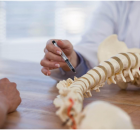Spondylosis is the change of the vertebrae and discs within the spine. Known as general wear and tear of the spine, the condition can produce pain, muscle spasms, or no symptoms at all.
Causes of Spondylosis
Since spondylosis is a result of wear and tear, it should be no surprise that aging is the root cause of the condition in many cases. The body is subjected to strain every day, and over time, this can take its toll on the spinal structures. Oftentimes, the joints and spinal structures begin degenerating long before symptoms appear.
While spondylosis often occurs as a result of aging, the way aging affects the spine can result in a cascade of other issues. One anatomical issue takes place, causing the spinal structure to degenerate further.
Degenerative Disc Disease Caused by Spondylosis
For many patients, spondylosis and degenerative disc disease (DDD) go hand in hand. The conditions are closely related because the intervertebral discs are generally the first area of the spine to experience wear. The change starts within the discs, but eventually, other areas of the spine experience change too.
Discs lose their sponginess and thin out over time. As the disc’s thickness decreases, the space between the vertebrae and the disc decreases, causing surrounding facet joints to change and putting pressure on nerves in the spine. Bone spurs may also occur, putting even more pressure on the spinal cord and nerves. Eventually, the spinal column may narrow in a condition known as spinal stenosis, but this doesn’t happen to everyone with spondylosis.
Lifestyle Changes to Control Spondylosis
Genetics is believed to play a role in your likelihood of developing spondylosis. While you may not be able to control your genes, there are lifestyle choices you can make to control your risk or reduce symptoms. Smoking, for instance, accelerates disc degeneration by drying out the water inside of them. Quitting or avoiding smoking, maintaining a healthy weight, and exercising regularly with low-impact cardio, strength, and stretching could help you prevent or control spondylosis.
Patients have been exploring options with regenerative medicine, also known as stem cell therapy. Stem cells have the ability to provide pain relief and regeneration effects to ligaments, tendons, cartilage, and connective tissues. If you are seeking an alternative, this option may be available for you.
This post was written by a medical professional at Stemedix Inc. At Stemedix we provide access to Regenerative Medicine for back pain, also known as degenerative disc disease. Regenerative medicine has the natural potential to help improve symptoms sometimes lost from the progression of many conditions.
